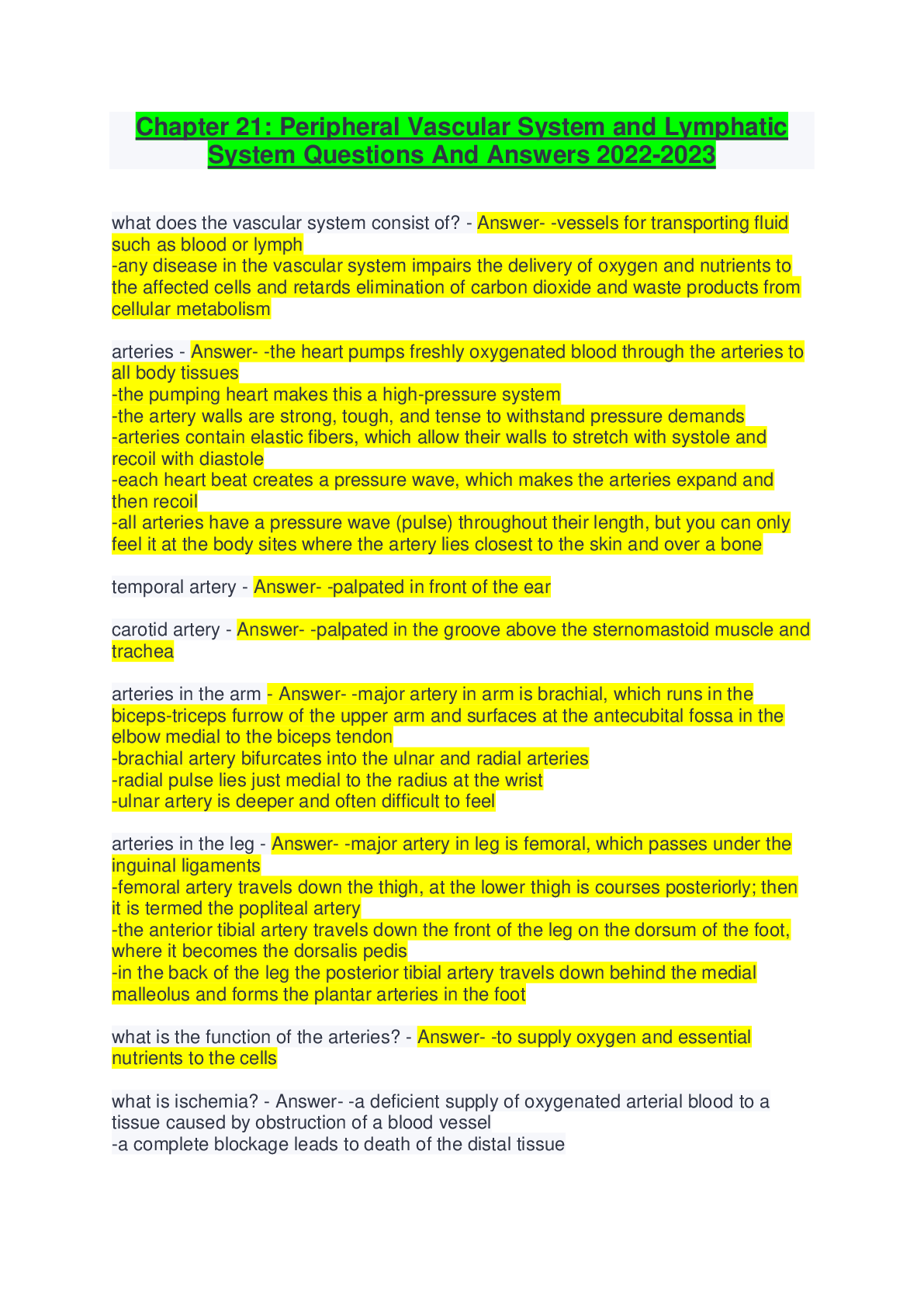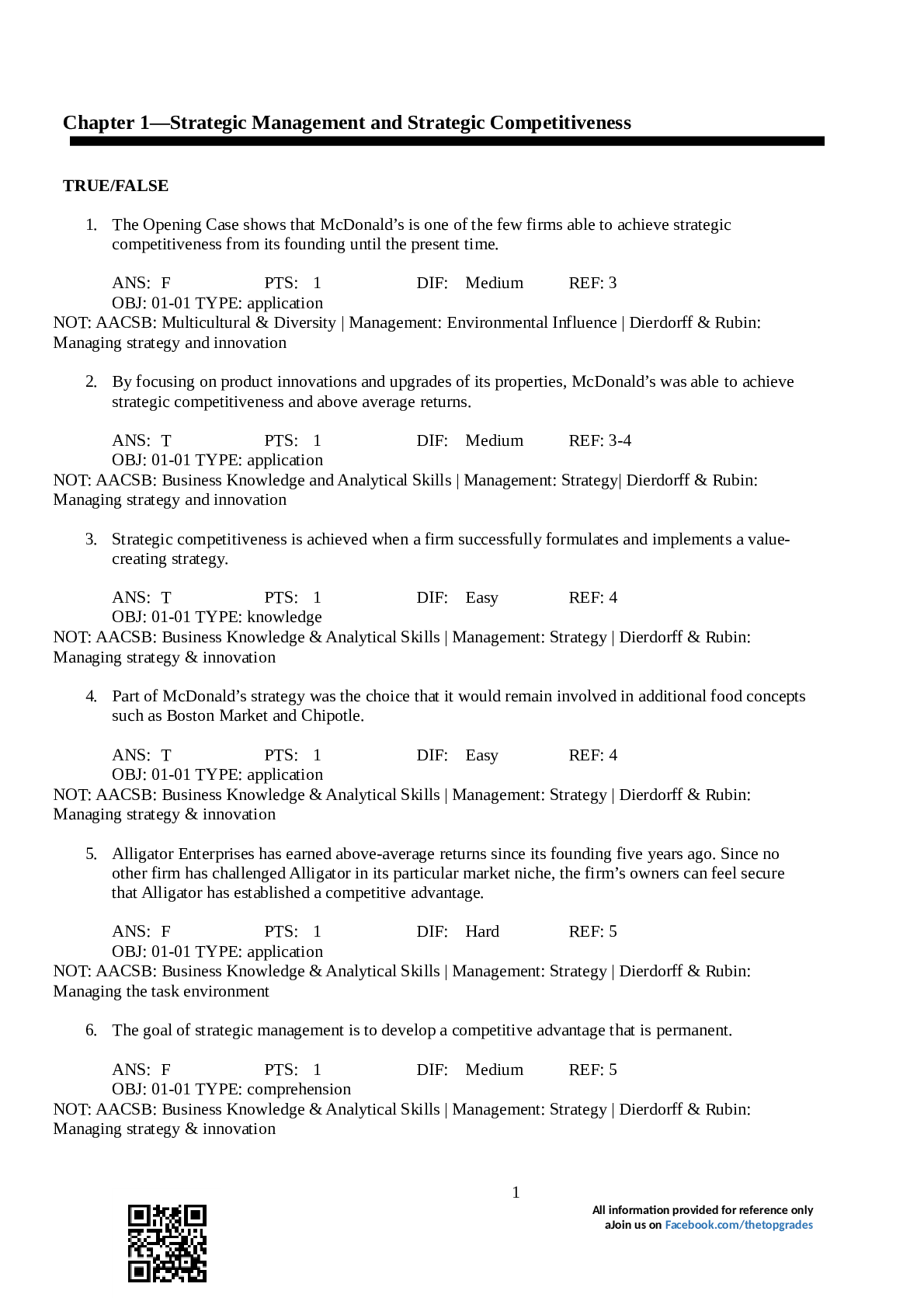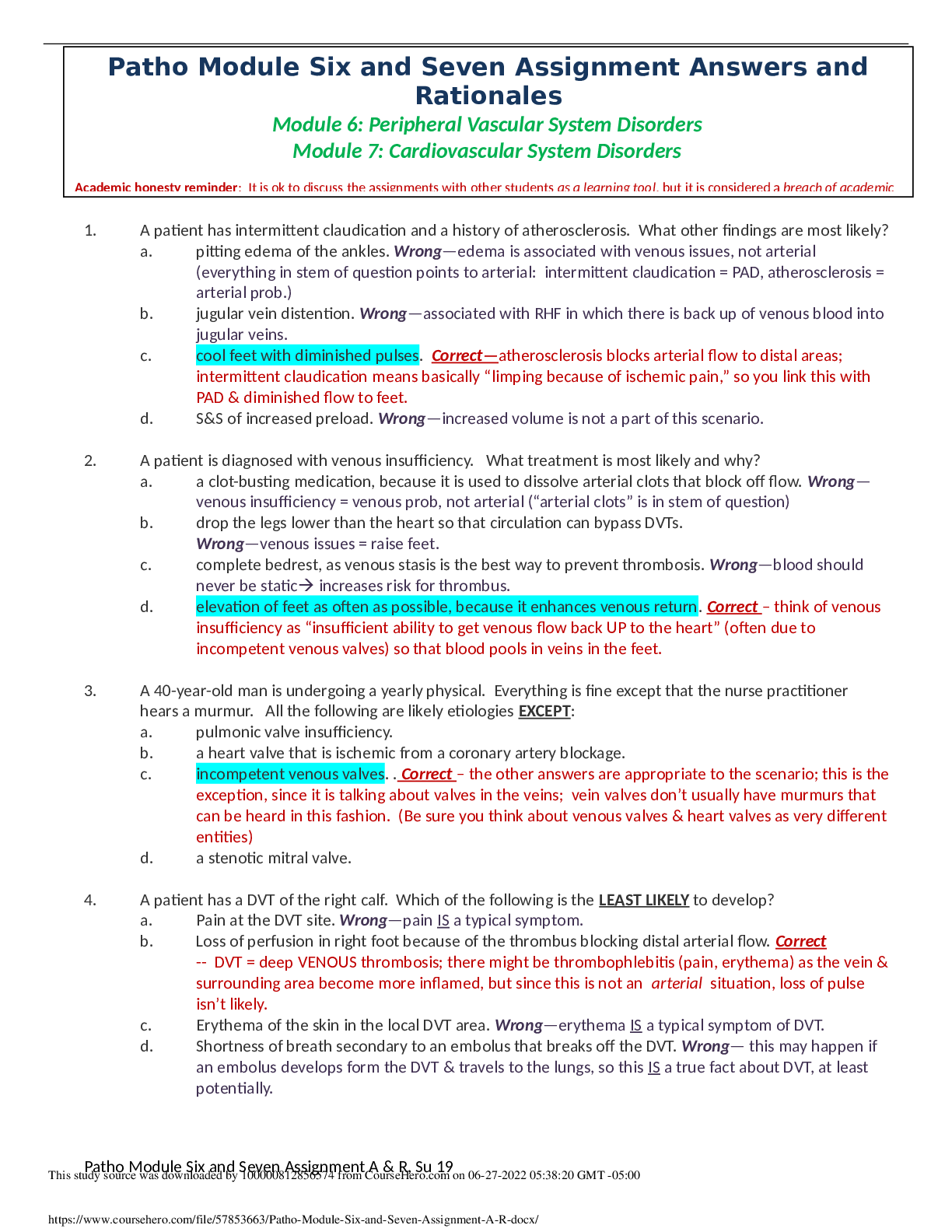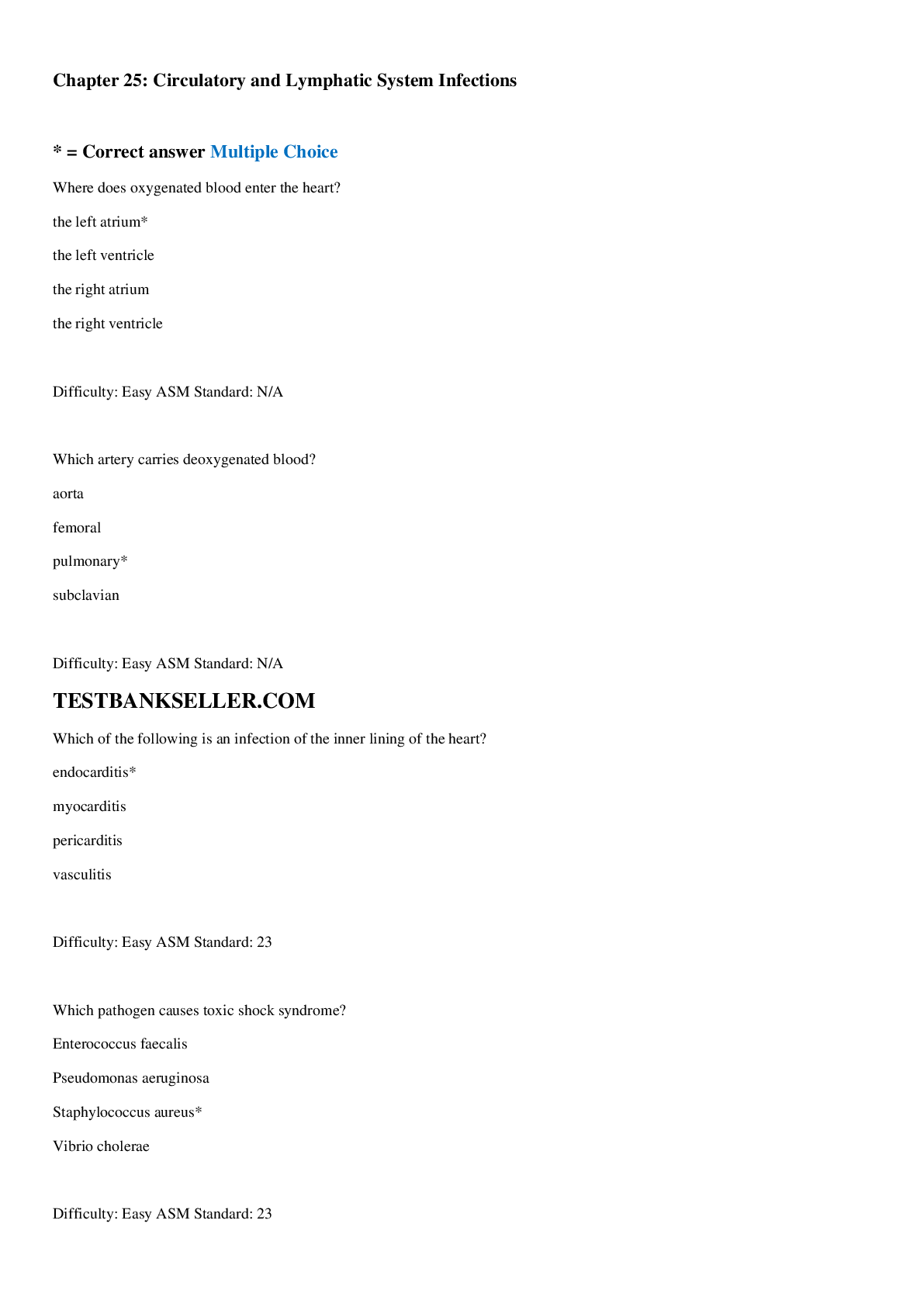*NURSING > EXAM > Chapter 21: Peripheral Vascular System and Lymphatic System Questions And Answers 2022-2023 (All)
Chapter 21: Peripheral Vascular System and Lymphatic System Questions And Answers 2022-2023
Document Content and Description Below
Chapter 21: Peripheral Vascular System and Lymphatic System Questions And Answers 2022-2023 what does the vascular system consist of? - Answer- -vessels for transporting fluid such as blood or ly... mph -any disease in the vascular system impairs the delivery of oxygen and nutrients to the affected cells and retards elimination of carbon dioxide and waste products from cellular metabolism arteries - Answer- -the heart pumps freshly oxygenated blood through the arteries to all body tissues -the pumping heart makes this a high-pressure system -the artery walls are strong, tough, and tense to withstand pressure demands -arteries contain elastic fibers, which allow their walls to stretch with systole and recoil with diastole -each heart beat creates a pressure wave, which makes the arteries expand and then recoil -all arteries have a pressure wave (pulse) throughout their length, but you can only feel it at the body sites where the artery lies closest to the skin and over a bone temporal artery - Answer- -palpated in front of the ear carotid artery - Answer- -palpated in the groove above the sternomastoid muscle and trachea arteries in the arm - Answer- -major artery in arm is brachial, which runs in the biceps-triceps furrow of the upper arm and surfaces at the antecubital fossa in the elbow medial to the biceps tendon -brachial artery bifurcates into the ulnar and radial arteries -radial pulse lies just medial to the radius at the wrist -ulnar artery is deeper and often difficult to feel arteries in the leg - Answer- -major artery in leg is femoral, which passes under the inguinal ligaments -femoral artery travels down the thigh, at the lower thigh is courses posteriorly; then it is termed the popliteal artery -the anterior tibial artery travels down the front of the leg on the dorsum of the foot, where it becomes the dorsalis pedis -in the back of the leg the posterior tibial artery travels down behind the medial malleolus and forms the plantar arteries in the foot what is the function of the arteries? - Answer- -to supply oxygen and essential nutrients to the cells what is ischemia? - Answer- -a deficient supply of oxygenated arterial blood to a tissue caused by obstruction of a blood vessel -a complete blockage leads to death of the distal tissue -a partial blockage creates an insufficient supply, and the ischemia may be apparent only at exercise when oxygen needs increase what is peripheral artery disease (PAD)? - Answer- -affects non-coronary arteries and usually refers to arteries supplying the limbs -it is usually caused by atherosclerosis (deposit of plaque from high cholesterol) and less commonly by embolism, hypercoagulable states, or arterial dissection veins - Answer- -the course of the veins is parallel to the arteries, but the direction of flow is opposite -the veins absorb carbon dioxide and waste products from the periphery and carry them back to the heart -the body has more veins, and they lie closer to the skin surface -walls of veins are thinner veins in the arm - Answer- -each arm has two sets of veins: superficial and deep -the superficial veins in the subq tissue are responsible for most of the venous return veins in the leg - Answer- -3 types of veins: deep veins, superficial veins, and perforators -deep veins: run alongside the deep arteries and conduct most of the venous return from the legs, these are the femoral and popliteal veins, as long as these veins remain intact, the superficial veins can be excised without harming the circulation -superficial veins: great and small saphenous veins, the great saphenous, inside the leg, starts at the medical side of the dorsum of the foot. the small saphenous, outside the leg, starts on the lateral side of the dorsum of the foot and ascends behind the lateral malleolus -perforators: are connecting veins that join the two sets, they also have one way valves that route blood from the superficial into the deep and prevent reflux to the superficial veins venous flow - Answer- -veins drain deoxygenated blood and its waste products from tissues and return it to heart -veins are a low pressure system what is the mechanism of venous blood flow - Answer- (1) the contracting skeletal muscles milk the blood proximally, back toward the heart (2) the pressure gradient caused by breathing, in which inspiration makes the thoracic pressure decrease and the abdominal pressure increase (3) the intraluminal valves, which ensure unidirectional flow, each valve is a paired semilunar pocket that opens toward the heart and closes tightly when filled to prevent backflow of blood -in the legs this mechanism is called the calf pump or peripheral heart what does efficient venous return depend on? - Answer- -contracting skeletal muscles -competent valves in the veins -patent (clear) lumen who is at risk for venous disease? - Answer- -people who undergo prolonged standing, sitting, or bedrest because they do not benefit from the the milking action that walking accomplishes -hypercoagulable states and vein wall trauma are other factors varicose veins - Answer- -some people have a genetic predisposition -venous pooling also occurs in obese people and women following multiple pregnancies lymphatics - Answer- -form a completely separate vessel system that retrieves excess fluid and plasma proteins from the interstitial spaces and returns it to the bloodstream -fluid moves according to a pressure gradient (filtration) what is hydrostatic pressure caused by? - Answer- -at the arterial end, the hydrostatic pressure is caused by the pumping action of the heart and pushes somewhat more fluid out of the capillaries than the venules can absorb what are the functions of the lymphatic system? - Answer- (1) conserve fluid and plasma proteins that leak out of capillaries (2) form a major part of the immune system that defends the body against disease (3) absorb lipids from the small intestine what are lymph nodes? what do they do? - Answer- -small, oval clumps of lymphatic tissue located at intervals along the vessels -most nodes are arranged in groups, both deep and superficial -they filter the fluid before it is returned to the bloodstream and filter out microorganisms that could be harmful to the body cervical nodes - Answer- -drain the head and neck axillary nodes - Answer- -drain the breast and upper arm epitrochlear node - Answer- -in antecubital foss and drains the hand and lower arm inguinal nodes - Answer- -in the groin and drain most of the lymph of the lower extremity, the external genitalia, and the anterior abdominal wall spleen - Answer- -located in left upper quandrant of abdomen four functions (1) destroy old red blood cells (2) produce antibodies (3) store red blood cells (4) filter microorganisms from the blood tonsils - Answer- -located at the entrance to the respiratory and gastrointestinal tracts and respond to local inflammation thymus - Answer- -flat, pink-gray gland located in the superior mediastinum behind the sternum and in front of the aorta -important in developing T lympocytes the aging adult - Answer- -arteriosclerosis (vessels become more rigid) -PAD -aging produces a progressive enlargement of the intramuscular calf veins -prolonged bed rest, immobilization, and heart failure increase the risk for deep vein thrombosis (DVT) and subsequent pulmonary embolism subjective data - Answer- -leg pain or cramps -skin changes on arms or legs -swelling in arms or legs -lymph node enlargement -medications -smoking history leg pain or cramps - Answer- -where, describe the pain (burning, aching, cramping, stabbing), gradually or suddenly, aggravated by activity, what relieves it, change in sexual function, history of vascular problems -with PAD blood flow cannot back muscle demand during exercise; therefore people feel muscle fatigue or pain when walking (claudication), but only 10% of those with PAD have this symptom -claudication distance is the number of blocks walked or stairs climbed to produce pain -night leg pain is common in aging adults, may indicate ischemic rest pain of PAD, severe night muscle cramping, or restless leg syndrome what are the risk factors for PAD? - Answer- -diabetes, smoking, age, cardiac disease skin changes on arms or legs - Answer- -swelling, when did it start, what time of day is it worse, does it go down, what brings it on, what relieves it -edema is bilateral when the cause is generalized (heart failure) or unilateral when it is the result of a local obstruction or inflammation lymph node enlargement - Answer- -swollen glands, where, how long, any recent change, hard or soft, pain -englarged lymph nodes occur with infection, malignancies, and immunologic diseases medications - Answer- -what are you taking (oral contraceptives, hormone replacement) -these may cause hypercoagulable state (can cause DVT) -low dose aspirin or clopidogrel is used to prevent blood clots in selected people smoking history - Answer- -cigarettes, how many packs per day, what age did you start, how many years -tobacco constricts arteries, increases coagubility, injures endothelium and promotes inflammation -smoking is the strongest risk factor for PAD Inspect and palpate the arms: What is the normal nailbed angle? - Answer- The normal nail-bed angle is 160 degrees. Profile Sign - Answer- view the finger from the side to detect early clubbing Capillary Refill - Answer- What is it? -Index of peripheral perfusion and cardiac output How do you do it? -Depress and blanch the nailbeds -Release and note the time for color return What is suppose to happen? -Usually the vessels refill within a fraction of a second -Consider it normal if the color returns in less than 1-2 seconds...... [Show More]
Last updated: 2 years ago
Preview 1 out of 14 pages

Buy this document to get the full access instantly
Instant Download Access after purchase
Buy NowInstant download
We Accept:

Reviews( 0 )
$10.50
Can't find what you want? Try our AI powered Search
Document information
Connected school, study & course
About the document
Uploaded On
Sep 04, 2022
Number of pages
14
Written in
Additional information
This document has been written for:
Uploaded
Sep 04, 2022
Downloads
0
Views
50














.png)





.png)





